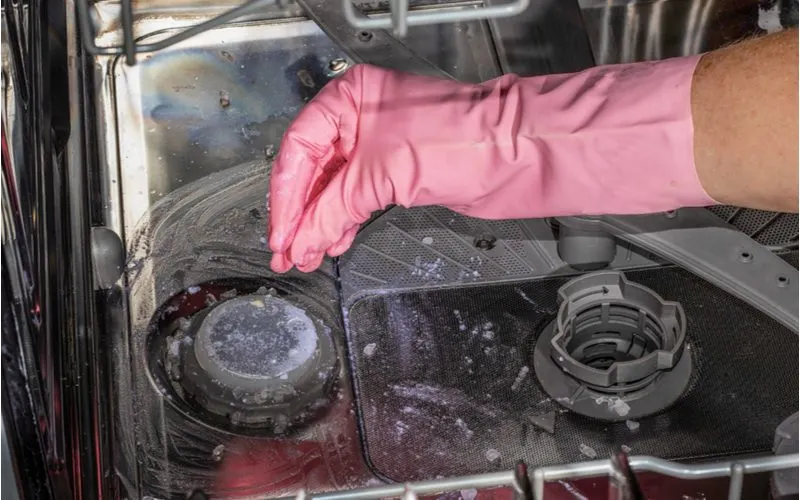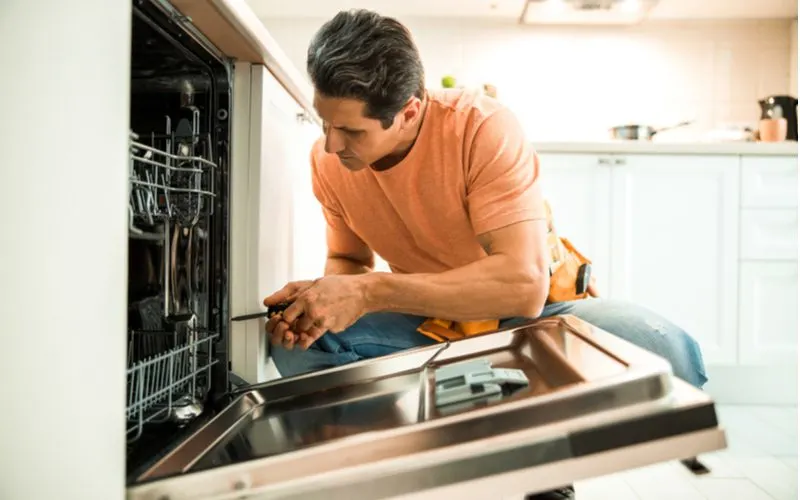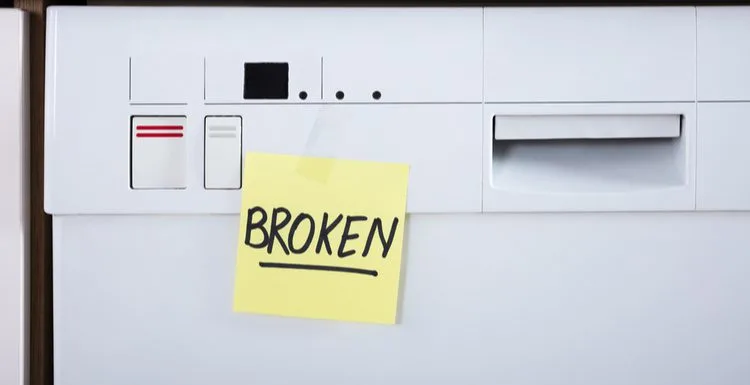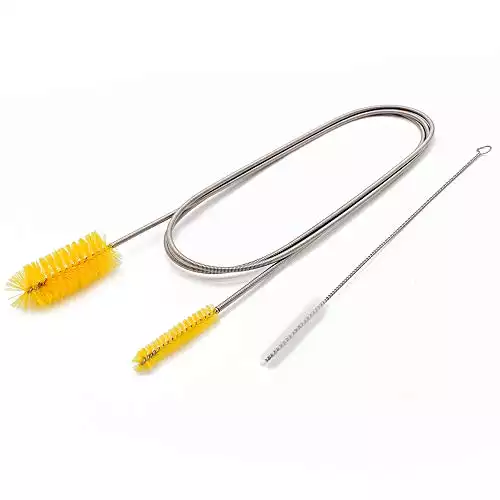Wondering how to unclog a dishwasher?
You’re in the right place. While the actual steps aren’t terribly difficult, there are a few considerations to keep in mind before trying. Read on to learn what these are and more.
We partnered with Networx to help you find local plumbers in your area. Click to below to get a FREE quote.
Has your dishwasher miraculously stopped functioning correctly? If that is the case, then you’ve probably already asked yourself the question, “How to unclog a dishwasher?”
It’s not an uncommon question, and there are several answers to it, so read on to learn some potential solutions to your predicament.
How to Unclog a Dishwasher: A Summary
Because there are multiple ways that a dishwasher becomes clogged, there are naturally various ways to unclog it.
In this article, we’ll cover the causes, solutions, and everything else you’ll need to know about dishwasher clogs in these steps:
- Step 1: Turn Off the Power and Remove All Dishes
- Step 2: Inspect the Bottom of Your Dishwasher
- Step 3: Start Ruling Out Potential Causes
- Step 4: Check Your Dishwasher’s Drain Hose
- Step 5: Check Your Dishwasher’s Main Drain and Filter
- Step 6: Clean Your Dishwasher’s Main Drain
- Step 7: Turn On the Garbage Disposal
- Step 8: Contact a Professional
- Step 9: Avoid Future Dishwasher Clogs
How to Unclog a Dishwasher in 9 Easy Steps

Iriniacapel/Shutterstock
Here are the nine steps that will help you get your dishwasher unclogged:
Step 1: Turn Off the Power and Remove All Dishes
Before you do any poking around in the depths of your dishwasher, remove any dishes and the bottom dish rack. You’ll need to see clearly for this process, so emptying the dishwasher is an essential first step.
Also, make sure that the dishwasher’s power is off, as it should go without saying that water and electricity do not mix. It’s critical to stay as safe as possible during this process, so please don’t forget this step!
Step 2: Inspect the Bottom of Your Dishwasher
Once the initial safety steps are complete, you’ll want to inspect the bottom of your dishwasher to determine its current state.
Here are two main things you can look for to determine whether you clogged your dishwasher or not.
These are leftover pieces of food and pools of water. Neither of these should be in your dishwasher unless you stop your dishwasher during its cleaning cycle.
In that case, your dishwasher will not have the time to drain waste completely, so you may see some food or standing water in the bottom. If you find food or water pools in your dishwasher, you can clean out the bottom and then dry it with a towel.
Step 3: Start Ruling Out Potential Causes
As stated earlier, multiple issues can cause a dishwasher to stop functioning correctly.
Because of this, you’ll want to focus on ruling out one potential cause at a time. With this approach, you’ll first want to inspect things that directly connect to or are inside your dishwasher.
Step 4: Check Your Dishwasher’s Drain Hose
The drain hose directly connects your dishwasher and garbage disposal, so a lot of stuff travels through it if you use your dishwasher regularly. For most dishwashers, you’ll find the drain hose in one of two places.
Either inside the cabinet that is beneath the sink or on the backside of the dishwasher. In either case, reaching the hose is not difficult, but if it is behind your dishwasher, then you’ll have to move your dishwasher out from the wall to get to it.
After you gain access to the drain hose, ensure that it is firmly connected to the dishwasher and give it a good inspection for any signs of damage or rust.
If you see any food or other debris clogging the hose, then you may have to disconnect it to clean it out manually.
Before doing this, have a bowl, pan, or something else beneath the hose to catch any excess water that might fall during the process. To clean the hose, you can use a standard drain brush.
Step 5: Check Your Dishwasher’s Main Drain and Filter
If the drain hose doesn’t turn out to be the source of your clogging problem, the next likely candidate is the dishwasher’s main drain.
The main drain is at the bottom of the dishwasher, and it has a basket-like shape that is not difficult to find.
More often than not, it’s in the middle of the dishwasher, so you will spot it immediately if the bottom dish rack is not still inside.
The main drain will also have a filter inside, and if it’s full of debris, this might be causing your clogging problems.
You might need a screwdriver to remove the screws holding the filter in place, but if there are no screws, then you can use your hand. Once the filter is out, remove any food lodged inside it and use soap and warm water to clean it thoroughly.
Step 6: Clean Your Dishwasher’s Main Drain
To clean your dishwasher’s main drain, use a mixture of half vinegar and half baking soda. Pour the solution into the base of the basket and allow it to sit for fifteen to thirty minutes.
That way, it will have enough time to affect whatever substances are blocking up the drain. After waiting for the appropriate time, fill a glass with hot water and pour it down the drain to clear it entirely.
Then turn your dishwasher’s power back on and run the rinse cycle to clean out any remnants of the baking soda and vinegar mixture, as you don’t want that to remain.
Step 7: Turn On the Garbage Disposal
Your garbage disposal can experience clutter even if you don’t use it often, so it’s another potential cause of clogging that you should check.
Turn on the garbage disposal and run cold water down the sink simultaneously until the disposal clears out completely. If you hear or see that something is inside the disposal, this may be what’s causing your clogging issue.
At this point, you can turn off the power to the garbage disposal and check the inner blades yourself to see or remove what’s lodged in there.
However, suppose you are not comfortable doing this yourself. In that case, you can instead contact a professional to do it for you.
Step 8: Contact a Professional
We partnered with Networx to help you find local plumbers in your area. Click to below to get a FREE quote.
If you follow all the above steps and find that your issue still persists, then it may simply be a situation where your dishwasher has a deeper problem that requires professional assistance.
Because there is no real downside to hiring a professional aside from paying for it, you should strongly consider going that route.
The last thing you want to do is try more extreme methods to fix your dishwasher yourself, only to end up making the situation even worse.
Of course, do your research before deciding who you want to hire to work on your dishwasher. That way, you’ll receive quality help and a fully repaired dishwasher in a reasonable amount of time!
Step 9: Avoid Future Dishwasher Clogs
Once you have your dishwasher fixed by either your handiwork or the work of a professional, you’re probably going to wonder, “How do I keep my dishwasher from getting clogged again?”
It’s an excellent follow-up question, and it’s why this last step is the most important of all.
So, to keep your dishwasher in good working condition, you will have to manage it properly from now on. Here are some general maintenance tips to keep in mind:
- Clean your dishwasher out regularly.
- Remove the dish racks and give the inside a good wipedown often.
- Do daily checks for food and other debris sitting in the bottom of your dishwasher.
- Don’t overfill your dishwasher with too many dishes.
- Rinse all your dishes off and make sure there is as little food on them as possible before putting them in your dishwasher.
- Use quality dish detergent every time you run your dishwasher.
- Conduct inspections on your dishwasher’s filter every other day and remove any food or debris that you find in it.
Following these tips does not guarantee that you will never have clogging issues with your dishwasher again. However, following them will minimize the chances of the problem occurring again.
Things to Consider

Olena Yakobchuk/Shutterstock
Here are some other valuable things to consider and keep in mind for everything we covered in this article:
- You may need to carry out all these steps, a few of them, or even one to fix your dishwasher, depending on how many things are clogging it.
- Before you start working on your dishwasher, always remember to turn off its power and also make sure you have all the tools you will need on hand.
- If you are unsure how to do something, like remove the drain filter, then do not do it. Instead, contact a professional for help.
- Never continue using your dishwasher if you know something is clogging it, as this will only worsen the issue.
- Rushing through each step will potentially lead to something getting broken or damaged, or the fix may not work at all because it did not get done correctly. So, always give yourself ample time to go through each step at a steady pace for the best possible results.
So, How Do You Unclog a Dishwasher?
So there you have it—how to unclog a dishwasher. While having a clogged dishwasher is the worst, fixing it is not a complicated process.
Just remember to put your safety first, carefully go through each of the steps we discussed, and contact a professional for anything you feel uncertain about doing yourself.
If you keep these three points in mind, you’ll have your dishwasher back in working order in no time!



